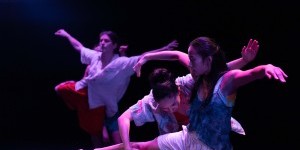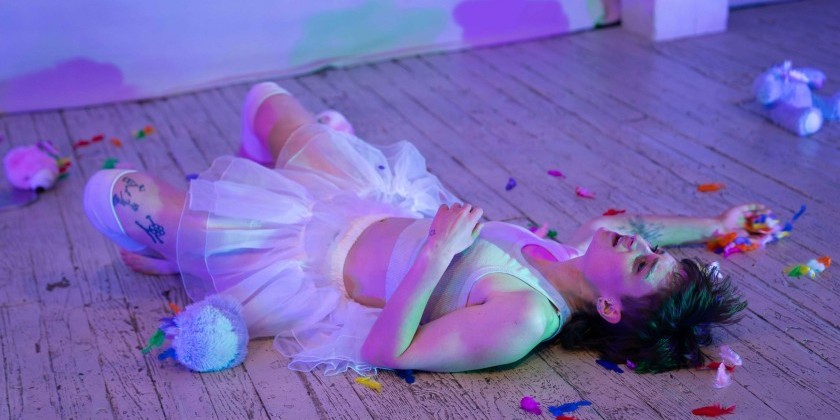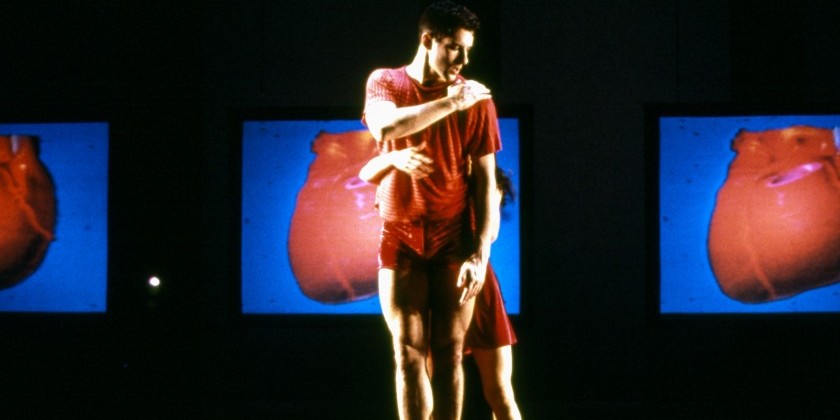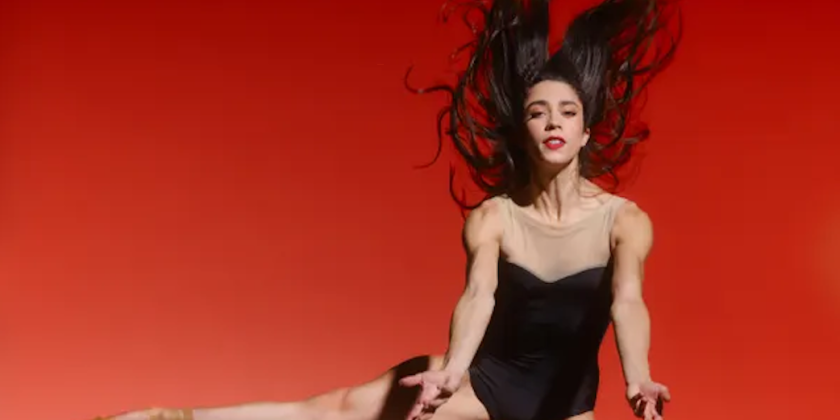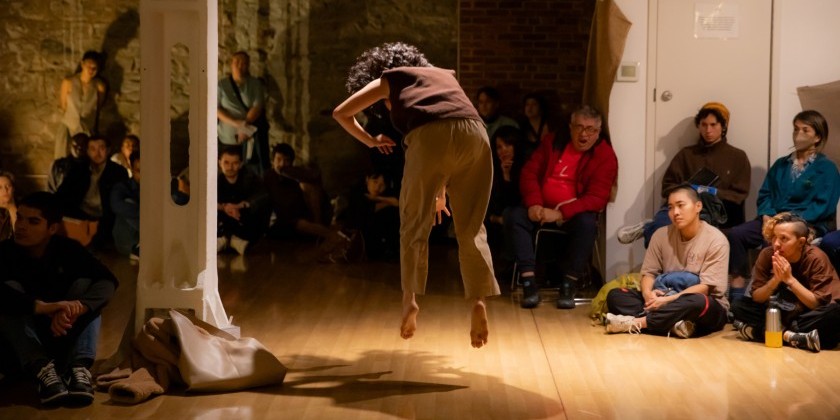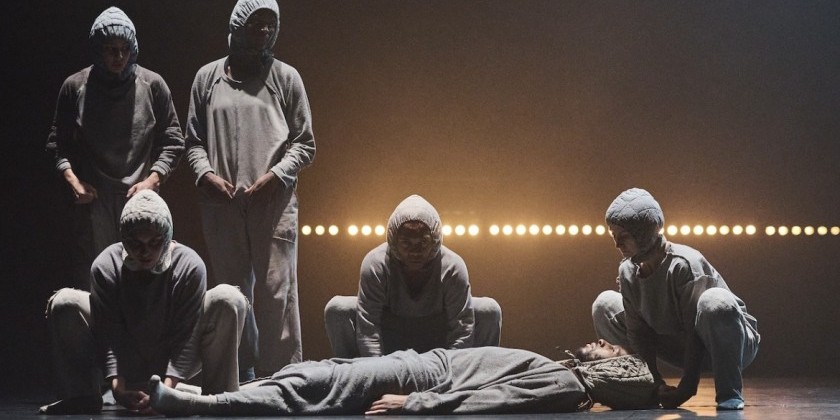AUDIENCE REVIEW: "The 4" by Pony Box Dance Theatre

Company:
Pony Box Dance Theatre
Performance Date:
June 17th, 2023
Freeform Review:
NYC-based Pony Box Dance Theatre (PBDT) presented The 4 at the Ailey Citigroup Theatre on June 17th, 2023. The evening featured four works, by celebrated choreographers Rena Butler, Norbert de la Cruz III, Yoshito Sakuraba, and PBDT’s Artistic Director Jamie Carabetta.
Yoshito Sakuraba’s “The Untold” was a reflective, fluid journey through memory and reality. The dance highlighted the experiences of a central figure, portrayed by Christian A. Warner. The figure found himself simultaneously grounded and pulled by four other beings, portrayed by Carl Ponce Cubero, Paulo Gutierrez, James Lindsay Harwell, and Kyle H. Martin.
Whistling winds and gentle piano ambiance opened the work. The opening atmosphere was impalpable, with Christian A. Warner lying face down at James Lindsay Harwell’s feet. Warner’s character may have been dreaming, or perhaps may have succumbed to something. He hoisted his body upright by gripping Harwell’s rooted ankles, and the two embraced. This moment served as an introduction to Warner’s dependence on the four beings to navigate their reality.
Joined on stage by Carl Ponce Cubero, Paulo Gutierrez and Kyle H. Martin, Warner became surrounded in the center. Led by Cubero, the four guided Warner to the floor; their supple movement qualities incorporated repetitive pulses, and longing gestures towards Warner. These relations swelled as the dancers began a series of larger partnering sequences, sweeping Warner into the air and gently placing him on Martin’s back. Warner was brought to the earth again, and the scenes dissipated into a series of solos, duets, and trios, each scene exploring the world of the five dancers. The sound score transitioned away from winds, incorporating gentle beats and the sounds of rain storms, maintaining a dreamy quality.
“The Untold” was interwoven with many technical moments of splendor: Kyle H. Martin’s suspended arabesques, Christian Warner’s multiple pirouettes (at one moment executing six and then moving into an inversion), Carl Ponce Cubero’s long, sustained tilts and supple hinges, and expressive group partnering with large lifts. While at times balletic in vocabulary, both Sakuraba’s choreography and the five dancers maintained an organic flow that felt natural and fascinating.
“The Untold” concluded with a beautiful duet between Christian Warner and Kyle H. Martin. It was at this moment where the music swelled to its most emotional, matching the energy of the Warner and Martin. The pair maintained a hand to hand connection throughout much of their partnering, releasing momentarily to then sweep one another in the air again. Their sense of tension, pull, and release was calculated and exquisite. In a variation of the piece’s opening, Warner was left on stage standing over Martin’s facedown body, implying that something exhilarating had occurred to get them to such a state.
---
Dynamic unison, call and response, and percussive strides dominated “The Table (excerpt).” This work in progress was created by PBDT’s Artistic Director Jamie Carabetta in collaboration with PBDT, and is a contemporary re-imagining of “The Green Table” (1932) by German choreographer Kurt Jooss. Nearly a century later, “The Table (excerpt)” captured the same call for action against the military-industrial complex as Jooss’ 1932 ballet.
Paulo Gutierrez’s opening solo was striking. After a tense moment of silence and stillness, Gutierrez strode down the downstage right diagonal, which was a precursor to the spatial arrangement where much of the group movement would later take place. Buoyantly jumping and stretching through the edges of his limbs, Gutierrez commanded the stage before leading out the five remaining cast members in a militant movement canon: Jonathan Colafrancesco, Carl Ponce Cubero, Kyle H. Martin, Nelson Mejia, and Christian A. Warner.
The canon of six morphed into unison, and the dancers arranged themselves across the stage in a diagonal. Gestures such as salutes, pointed fingers, bladed hands, and raised hands shielding their faces were incorporated into their movement. A driving drum and crashing symbols encompassed the sound score, along with emotional vocals. Jonathan Colafrancesco broke out from the diagonal; the remaining five circled around Colafrancesco, who repeatedly brought a saluting gesture to his forehead to then remove it. Soloists continually broke out from the diagonal, to be encircled by the remaining dancers before resuming the diagonal. Each return from circle to diagonal was seamless and fluid.
The music temporarily shifted from the beating drums into a more lyrical sound score driven by the vocalist, though the dancers maintained their sharp musicality. At the music’s return to the sinister drums, the diagonal shifted to a clump – Paulo Gutierrez and Jonathan Colafrancesco introducing a march – which the group joined. A siren, footsteps, and a new vocal score came on the sound score and the group began a new unison phrase in place: the group’s precision, speed, and focus were impactful.
After another group unison – this time with the six spread throughout the space in two lines – “The Table (excerpt)” introduced a different mood with duets and solos. These scenes incorporated sustained, less staccato movements, which rippled with pull and connection.
Throughout the dance, Paulo Gutierrez appeared to be an orchestrator of events, at one moment pointing his finger on a high diagonal followed by four artists charging into the space. Gutierrez, along with the entire cast, maintained a sense of comradery; the duets and solos which occurred in the latter half of the work particularly highlighted the amount that the artists had to work together in order to continue forward. As a whole, “The Table (excerpt)” highlighted PBDT’s musicality and precision without sacrificing emotion and communication, as well as offered a contemporary, equally relevant take on Jooss’ “The Green Table.”
---
“Four of Hearts” by Norbert de la Cruz III brought a lightness to the program in all accords of subject matter, movement, music, stage lighting, and costuming. The quartet – danced by Felix Bryan, Carl Ponce Cubero, Paulo Gutierrez, and Kyle H. Martin – explored the dynamics of modern-day relationships both playfully and earnestly.
While the dance’s title suggested an exploration of playing cards (Would there be a literal four of hearts playing card? Would there be clubs, spades, or diamonds?), the “four of hearts” was depicted on the dancers’ white vests, which were layered over white tank tops and white long pants. On the vests, a red heart was placed in different locations: on the chest, the back, the left hip, the right side of the torso. The costuming could be a nod to wearing a heart on one’s sleeve, or a suggestion that each human displays their hearts, affection, and views of love slightly differently than one another.
“Four of Hearts” was set to music by Shirley Bassey and Andy Williams, which no doubt contributed to the dance’s charm. But the true gems of the work were the dancers themselves. They interwove between solos, duets, trios, and dancing together as four; at times there was an audible heartbeat, at times the dancers used their own voices. They constantly found ways to connect with one another, literally and emotionally.
A memorable image of all four dancers came after a moment of stillness. Kyle H. Martin is pulled upstage by the other three, who then breaks out of the clump and charges right and left. The music dissipates, leaving only the sound of a heartbeat. Felix Bryan, Carl Ponce Cubero, and Paulo Guierrez alternated manipulating Martin’s stance, and then surrounded Martin with clapping and vocalizing. The three placed a single finger on Martin’s skull and guided Martin to the floor. Bryan and Guierrez lean over Martin, creating a giant heart shape with their arms, and Cubero slid in the center of the heart while speaking. The literal creation of a giant heart was such a fleeting moment, yet it was lasting.
Another playful moment occurred during Shirley Bassey’s song, “If You Go Away.” The choreography made shape of the strumming of a guitar. The quartet found themselves arranged on the floor with their heads stacked on top of each other. After three soft strums, the dancers – keeping their heads connected and stacked – fluttered their arms and legs up along with the guitar sounds. It was humorous, and full of breath. Later, Cubero – legs arranged in a second position – supported Guierrez so that Guierrez could lean backwards. Cubero strummed Guierrez like a guitar, and Guierrez’s legs and arms fluttered up, almost as if he were convulsing. The release and abandon found throughout “Four of Hearts” were refreshing and exciting.
---
Rena Butler’s “mask4masc” concluded The 4 on a lasting, meaningful note. The work brought to question how men can be authentically who they are, without being constrained to society’s definition or stereotypes of masculinity. “mask4masc,” which was made in collaboration with PBDT, was danced – powerfully and vulnerably – by Carl Ponce Cubero, Paulo Gutierrez, James Lindsay Harwell, Kyle H. Martin, Nelson Mejia, and Christian A. Warner.
The opening sequence of “mask4masc” felt very internal. The six dancers, spread across the stage in a horizontal line, slowly walked downstage. Some gestures were visible: Cubero raised his fists in front of his face, Harwell placed his fisted right hand on his chest. As the music swelled, the six formed maintained their horizontal line – the scene was tense, as the dancers looked ready to defend themselves from an outside force. Most of them stood hunched over, almost wilting. This made their unison rise all the more powerful.
The six dancers then revved themselves up, as if they knew something was about to take place. The energy they built in this moment lasted for the entirety of the work. They sprung up and down, they beat their chests, and they raised their arms in power positions.
Exploding into unison, the dancers propelled through the space, their movement largely driven by their torsos and pelvises. Their use of hands was also very evident, as outstretched palms seemed to slap against an invisible wall. The six leaned all the same way, falling together, and transitioned into several group lifts where each were carried, flipped, and lowered back to the ground. In these moments, the dancers shared trust and communication, and a sense of abandon when swung through the air.
Each of the dancers vulnerably explored – through process and performance – what it means to be exactly who they are. Throughout “mask4masc,” each artist was given space to display themselves and their stories.
The revved-up confidence morphed, at times, back into scenes of uncertainty and hurt. In silence, the six lined up in a diagonal and jolted backwards, as if affected by something in front of them. Taking small steps backwards, the dancers opened their mouths widely and yelled in anguish before four of them collapsed to the floor.
The dancers continually experienced moments where they were electrified by an outside force – which was perhaps societal stereotypes and expectations, or the expectations they placed on themselves. They then took ownership of who they were, and carried the electricity through their own movements. The dynamic of “mask4masc” bounced between discovery and display of that newfound confidence, and the raw exploration was incredible to witness.
The 4 by Pony Box Dance Theatre was an electrifying program. This company is definitely one to be on the lookout for!
Author:
Kristen Hedberg
Website:
kristenhedberg.org
Photo Credit:
Photo by Nir Arieli. "The 4" flyer edited by Studs Terkel.





